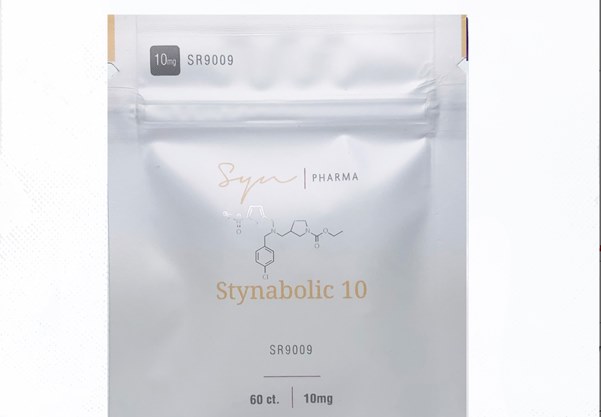Whether or not SR9009 is a beneficial chemical for fat loss and endurance is the subject of much debate. This unique guide will provide you with all the information about stenabolic drugs.
This post contains dosing details, stenabolic side effects, outcomes, and the best place to purchase this compound to determine whether this chemical is worthwhile.

What Exactly is SR9009?
Stenabolic (SR9009) is a substance used in research. So far, there have been no studies about the use of SR9009 on people. In mice, it increased endurance and decreased anxiety, cholesterol, weight, and inflammation. If demonstrated in humans, these results might mirror some of the health benefits of exercise.
However, Stenabolic has never been evaluated on people! Likewise, its adverse effects are unknown. Our bodies operate in 24-hour cycles synchronized with the sun’s rising and setting. This rhythm is known as the circadian rhythm.

The circadian rhythm is preserved by a feedback loop that alternately activates and deactivates genes (for example, the CLOCK and BMAL1 genes, when activated, also activate the PER and CRY genes). PER/CRY then deactivates BMAL1/CLOCK, resetting the 24-hour cycle). There is a pair of proteins, REV-ERBs, which are responsible for stabilizing our internal clock by inhibiting BMAL1. They, in turn, become active due to the heme group. Heme is a tiny iron-containing molecule found all over our bodies.
Agonists like SR9009 increase the activity of REV-ERB and are accessible for the body to use. Due to the numerous favorable results in animal studies, SR9009 has made its way online and is famous amongst bodybuilders as a supplement. The product has been called “workout in a bottle.” Nonetheless, there are still many unknowns concerning this medication, mainly where to buy Stenabolic and its potential effects.
Interactions of SR9009 with the Human Body
All observed effects of SR9009 result from REV-ERB (NR1D1, NR1D2) expression in the body. REV-ERB alters mice’s activity and sleep habits by affecting their circadian behavior. Besides affecting circadian rhythm (inhibition of BMAL1 synthesis), REV-ERB affects other energy production-related processes.
It also activates genes that produce new fat cells and decreases inflammation (by affecting macrophage production), with the following specifics:
- Liver: REV-ERB influences the rhythm of 90% of the approximately 900 genes under circadian regulation in mouse liver. It inactivates the glucose-producing genes without affecting insulin sensitivity. In addition, it activates genes responsible for forming new fat cells and lowers the inflammatory response (by regulating macrophage development).
- Muscles: REV-ERB enhances fat burning, mitochondrial activity, and mitochondrial synthesis while lowering mitochondrial degradation.
- Fat Cells: REV-ERB inhibits the genes responsible for fat storage and reduces triglyceride generation in fat cells.
In the Stenabolic review on animals and cells, some observations include:
- Consumption of more oxygen
- Reduced production of new fat cells within the liver.
- Reduced hepatic synthesis of bile acids and cholesterol.
- Increased number of muscle mitochondria.
- Increased muscular glucose and fatty acid burning.
- Reduced fat accumulation.
Research-backed Impacts of SR9009
1. Weight Loss

Mice given SR9009 for seven days lost weight because their fat mass went down, although the amount of food intake didn’t change. Similarly, obese mice on a strict diet received SR9009 for 30 days and lost 60% more mass than the control species. Total cholesterol, triglycerides, insulin levels, and free fatty acids in the blood went down. After 12 days, SR9009 stopped genetically obese mice from gaining weight without changing their blood sugar levels or how well they use insulin.
2. Cholesterol in the blood
When mice were fed SR9009 for 7 to 10 days, the number of triglycerides and total cholesterol in their blood went down. For eight weeks, scientists gave SR9009 to genetically modified mice fed on a high cholesterol diet for a fat profile like humans. Total cholesterol and triglycerides went down, but LDL cholesterol went down more than HDL cholesterol.
3. Endurance
After SR9009 was administered to mice for 30 days, they continued running for longer periods and went farther than the controls. SR9009 made muscle cells have more active mitochondria and total mitochondria (by suppressing autophagy genes).
4. Minimizing Inflammation

SR9009 got rid of the inflammation in rats’ lungs (through the decrease of TNF-alpha production). It also stopped rat nerve cells from making molecules that cause inflammation (CCL2, MMP-9).
5. Heart Problems
Scientists gave SR9009 to genetically modified mice likely to get hardened arteries for seven weeks. The blood vessel lesions got smaller, but the food intake, body weight, and blood fat levels did not change. When SR-9009 was injected into both normal and genetically altered old mice for 28 days, it made their hearts work better. When researchers gave SR9009 to mice for two weeks, it decreased the size and heart weight that had been made bigger by surgery (hypertrophy).
6. Fibrosis/Tissue Damage
When mice with liver scarring caused by SR9009 received the drug for two weeks, the damage to the mice’s tissues reduced significantly.
7. Wakefulness
As a REV-ERB activator, S9009 changes how mice sleep and wake up. But its effects are short-lived; they only last for 12 hours. Mice given SR9009 during the day, when they should have been sleeping, were more active and slept less deeply (less REM and slow-wave sleep). But when SR9009 was administered at night, when mice are most active, there were no changes. Hence, SR9009 might help people stay awake when their bodies want to sleep.
Side Effects

Although you can offset the perils of most chemical compounds, there will always be some trade-offs, and that’s no surprise. Here are some SR9009 side effects you may encounter:
- Liver toxicity
- Insomnia
Just keep in mind that the entire safety profile of this drug is still unknown.
Dosage
Thus far, no standard SR9009 dosage for humans. In most experiments with mice, researchers gave a dose of 100 mg/kg intraperitoneally or actively into the body cavity. On the other hand, online bodybuilding forums suggest a Stenabolic dosage of 10 mg to 40 mg three to four times a day.
Conclusion
Generally, athletes utilize Stenabolic because it can increase endurance and promote fat loss. Despite minimal data on this medication, user reports indicate that it has few adverse effects. However, you cannot conclude that it is safe for use unless you buy it from a trusted Stenabolic Canada supplier like Canadian Anabolics. Some websites offer it for sale, although the quality may be questionable. Therefore, we suggest purchasing from a reputable source.
References
https://pubmed.ncbi.nlm.nih.gov/18037887/
https://www.ncbi.nlm.nih.gov/m/pubmed/22633688
https://www.ncbi.nlm.nih.gov/pubmed/22460952
https://pubmed.ncbi.nlm.nih.gov/23852339/
https://pubmed.ncbi.nlm.nih.gov/18511497/


 UPDATED November 18th, 2025
UPDATED November 18th, 2025